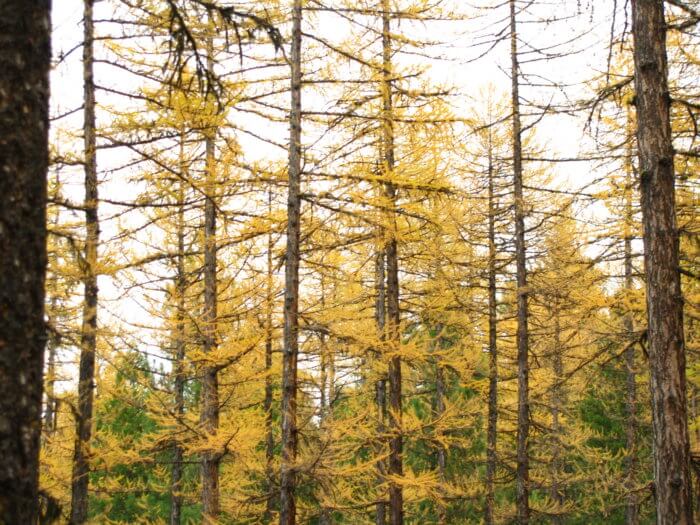Western Larches
by Natasha Bellis
Broadcast 10.9 and 10.18.2016

Photo by Allison De Jong
Listen:
Sitting on the shores of Lake McDonald in Glacier National Park last fall, gazing up at the surrounding hillside, I was struck by a unique mosaic of golden splendor against the evergreen background. The largest of its species, the western larch, Larix occidentalis, is indeed a unique kind of tree.
A deciduous conifer, the western larch possesses delicate, feathery needles where most deciduous trees have hardy leaves. It sheds these needles come fall, while most conifers remain evergreen. The western larch gives definition to the dense, autumn forests of western Montana, dotting the landscape with the saffron design of its distribution. Sitting along side Lake MacDonald, I began to wonder if these configurations were in some way indicative of western larch ecology or if they were only accidental.
I found that the western larch does provide more than fall aesthetics. Highly shade intolerant, the western larch relies on natural disturbance to perpetuate, or it risks being replaced by more shade tolerant conifers, such as the Douglas-fir. Historically, in western Montana, this disruption came in the form of wildfire, and thus, the western larch evolved to a landscape shaped by fire. There are three main characteristics that enable the larch to coexist with fire and secure its distribution.
First, the deeply furrowed cinnamon bark of a mature western larch contains little resin and can be up to six inches thick at the base. While this makes it easy for western larch to resist ground fires, most other trees cannot and are thus “thinned” in the process. Second, as Larix occidentalis grows, it sheds its bottom-most branches and builds its canopy high off the forest floor, making it less susceptible to crown fires. Lastly, the seeds of western larch propagate best in the mineral-laden soil exposed by fire. Thus, seeds of mature larch that do survive severe fires are the first to establish an area. And because the seeds are winged, they are easily spread on the wind. Combined with the rapid initial development of seedlings, these adaptations have earned western larch the title of a seral, or pioneer species in western Montana forests.
A severe fire in 1929 created the scattered patterns of western larch seen today on the slopes around Lake MacDonald. Old growth western larch that survived this fire still stand, surrounded by generations they have helped to propagate. Wildfires continue to ignite the landscape in western Montana, but fire suppression has been prevalent in modern management practices and recent disturbance has taken the form of harvesting with prescribed burns. While these techniques try to simulate the conditions of fire, research suggests they are no replacement for the natural disturbance to which these trees have adapted. Precise reasons for this are unclear but are indicated by lower seedling survival.
Whether natural or managed, the mosaics displayed by western larch as its needles turn yellow and begin to fall recall a history of the landscape. This fall, look past the golden-lined rivers of the Clark Fork and the Bitterroot, and treat your senses to the alpine design western larch display. Listen with your eyes as the western larch tells the story of its distribution.
Every week since 1991, Field Notes has inquired about Montana’s natural history. Field Notes are written by naturalists, students, and listeners about the puzzle-tree bark, eagle talons, woolly aphids, and giant puffballs of Western, Central and Southwestern Montana and aired weekly on Montana Public Radio.
Click here to read and listen to more Field Notes. Field Notes is available as a podcast! Subscribe on iTunes, Google Play, or wherever you listen to podcasts.
Interested in writing a Field Note? Contact Allison De Jong, Field Notes editor, at adejong [at] montananaturalist [dot] org or 406.327.0405.
Want to learn more about our programs as well as fun natural history facts and seasonal phenology? Sign up for our e-newsletter! You can also become a member and get discounts on our programs as well as free reciprocal admission to 300+ science centers in North America!












